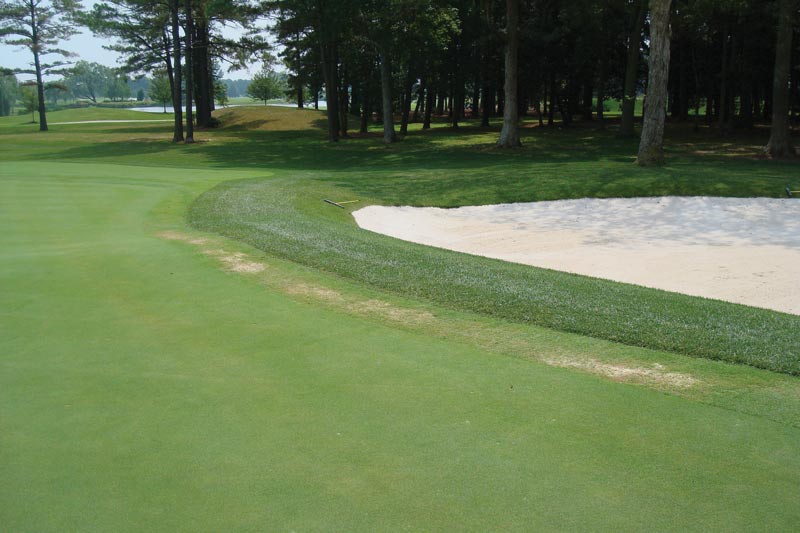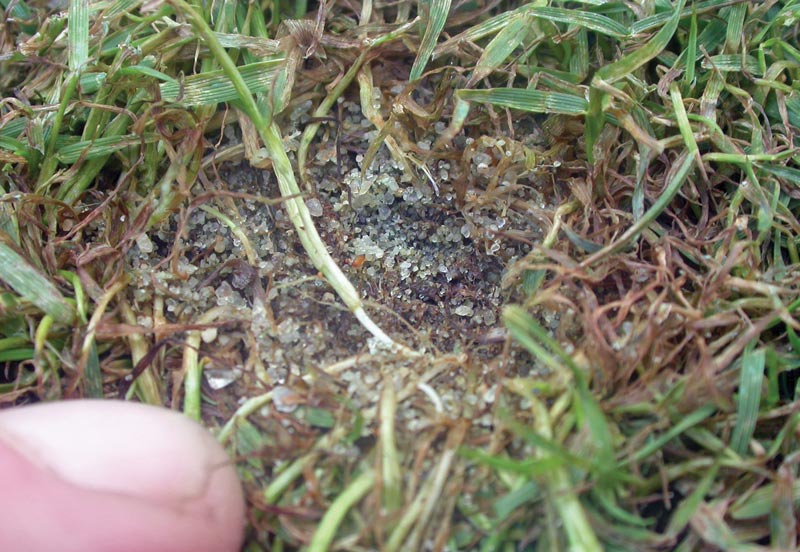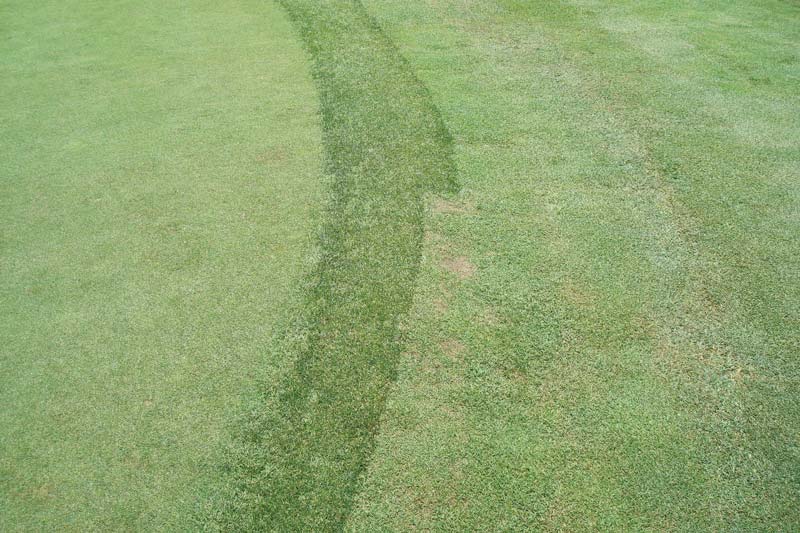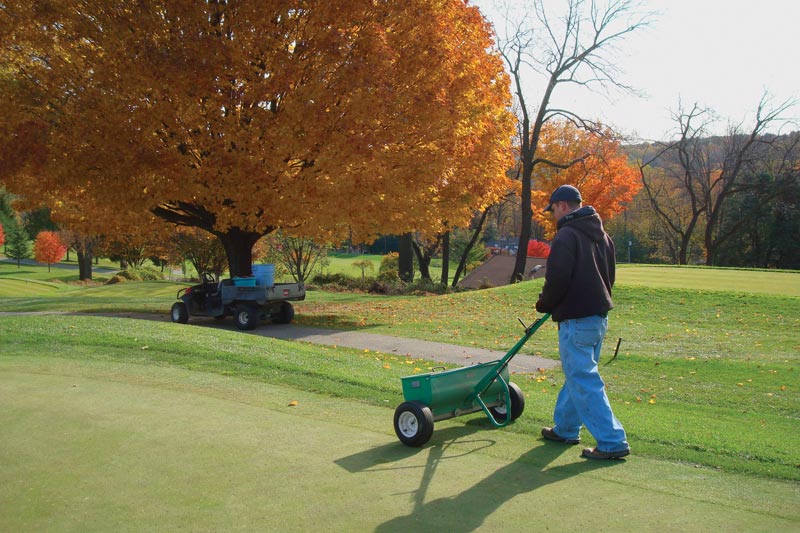
Collars present a unique management challenge for golf course superintendents. Generally, the most problematic areas are near bunker complexes and the front and back of greens. Photos courtesy of Steven McDonald
Collars are extremely important to the playability and aesthetics of a golf green complex, creating definition between the putting surface and the rough. However, collars are among the most difficult areas to manage through the summer months, especially on golf courses with high-density cultivars of creeping bentgrass (Agrostis stolonifera).
Over the past six years, I’ve consulted with more than 300 golf courses in the Mid-Atlantic region, and I get many questions about collars: Is it disease or insect damage? Is it mechanical damage? What can be done to help collars look and perform better?
As a researcher and turfgrass consultant, I make recommendations based on science and data, but unfortunately, there hasn’t yet been specific research conducted on collar management and maintenance practices, and there is only one published discussion on this subject (Dernoeden, P.H. 2002. Creeping Bentgrass Management: Summer Stresses, Weeds and Selected Maladies. John Wiley & Sons Inc. 32-35.). In that discussion, Dernoeden notes that the decline of collars is a “complex phenomenon.”
To maintain putting green surfaces at the desired playability levels, collars are often subjected to extreme mechanical and environmental stresses. Here, I’ve compiled a set of 13 potential solutions (based on observational evidence) and management techniques for improving the appearance of collars.
1. Increase sunlight and air movement
For newly renovated or constructed greens, ultra-high-density bentgrass cultivars appear to require more sunlight compared with the older bentgrass cultivars, perennial ryegrass and Poa annua. This is especially true when they are subjected to concentrated wear and aggressive cultural practices.
The damage and stress from mowers turning and foot traffic is worse in shaded and wet areas. Turf managers should pay special attention to their irrigation practices and irrigate only those areas that are dry and not areas that are thinned from traffic, sand or other factors. The decline of collars is worse in wetter soils. Check irrigation heads in green surrounds to ensure they are not overlapping onto collar surfaces. If they are, adjust them if possible.
2. Schedule topdressing for cooler days
Although it’s necessary to topdress putting greens and, to a lesser extent, the collars with sand, timing may increase the likelihood of injury. The warming of sand can damage leaf tips. The longest days of the year are in June, and many times the decline of collars begins in late June and continues through the summer. Sunlight duration and sun angle increase the warming of sand particles. A study at Ohio State showed that the canopy temperature of a Penncross putting green increased by 18 degrees following topdressing . A similar canopy temperature effect can occur on collars wherever the sand from bunker shots lands.

This collar-height creeping bentgrass has begun to decline. Notice that the stem bases of these plants are healthy and that all damage is to the upper canopy. Some of the leaves have small pinholes, which were caused by the abrasive properties of extremely angular sand.
Be aggressive with topdressing only when the weather allows. This may only be April, May, September and October (Mid-Atlantic region). When topdressing is on the agenda, be sure to watch the forecast for daytime high temperatures for the next seven to 10 days. If temperatures will be near 90 F on any of those days, topdressing may do more harm than good. If there is a five- to seven-day period in the summer when days will be cool (<85 F), then light amounts of sand may be prudent.
If you plan to get aggressive and topdress during the heat, try to keep sand off the collars. Also, topdress when the canopy is dry so the sand particles can move down to the stem bases and off the leaf tissue. This may prevent much of the heating and subsequent damage to the leaf tips.
3. Make your leaf blower do double duty
Use a leaf blower to blow the sand off the collar canopy after topdressing or prior to mowing the green in the morning. This should reduce the abrasive properties of the angular sand. Following days of heavy play, it may be wise to whip or blow sand off the green and collar areas around bunkers. Many collar areas that thin quickly are typically adjacent to bunkers that routinely come into play.
Be careful not to “stand up” creeping bentgrass plants that have elongated, which may lead to scalping. Some bunker sands can be extremely angular and cause damage to leaves.
Although blowing sand off the collar is labor-intensive, it may reduce the injury to collars.
4. Keep your mower turns covered
Use mats, rugs, plywood or plastic lattice for turning the greens mower, especially in areas vulnerable to traffic. These covers prevent the torque and twisting of the mower as it passes over or turns on the collar. Merely passing the mower over the collar, with the back roller moving the machine, can produce enough friction to cause mechanical injury to bentgrass.

During summer, turning mowers on a physical cover reduces mechanical wear to collars from walk-behind mowers. Over time, even moving the mower over the collar and turning in the rough will cause the collar turf to decline.
Collar decline is rarely an issue where triplexes are used to mow greens, perhaps because traffic doesn’t become concentrated in the same areas, or because there is less torque than there is from the rear roller that propels a walk-behind mower. This indicates that the torque of walk-behind greens mowers turning on concentrated areas contributes to collar decline.
I have noticed that collar decline is typically worse in spots that are sandy, wet and highly trafficked, and where hand mowers have little room to turn. Wear from greens mowers also appears to be worse on sloped surfaces of collars. Typically, this is the front and rear of the green and adjacent bunker complexes. These areas are also the most problematic for maintaining creeping bentgrass on collars.
5. Slightly increase amounts of nitrogen
Because collars have a lot of traffic and equipment turning on them, providing extra fertility for them will help the plants recover more quickly. When collars decline, it’s usually the leaf tissues that are affected more than the stems. An increase of 0.2-0.3 pound of nitrogen per 1,000 square feet per month during the summer would have a large impact on stimulating growth of leaf tissue.
Use a drop spreader with granular fertilizer so that more nutrients will be taken up by the roots and by the crowns, which form the key carbohydrate storage organ. Use a natural organic fertilizer that contains no urea or other sources of water-soluble nitrogen that may cause burn in summer.
6. Use aggressive creeping bentgrass cultivars
Cultivars such as Penncross, PennTrio and Princeville have shown some promise for use as collar turf compared with the ultra-high-density cultivars (A-1, A-4, G-2 and G-6). Older cultivars (such as Penncross) seem to produce more leaf tissue to withstand traffic better and also appear to have better recuperative ability. I have seen golf courses throughout the Mid-Atlantic region sod or seed Penncross or perennial ryegrass into collars after a single season of little success managing high-density bentgrass cultivars.
Cultivar selection may be only one small factor in bentgrass collar decline.
7. Seed perennial ryegrass into collars
Mechanical damage is less likely to occur to perennial ryegrass (or, to a lesser extent, Poa annua) collars than to creeping bentgrass collars. Perennial ryegrass has a bunch-type growth habit with a lot of upright leaf tissue, through which sand more easily moves into the lower crown tissue. Perennial ryegrass has excellent wear tolerance, which is why it is commonly used in Europe for high-traffic field sports like soccer. Creeping bentgrass, which is stoloniferous, produces a lot of horizontal leaf tissue. Basically, there is more leaf surface area exposed to damage when managing creeping bentgrass.

The front portion of this collar was originally 100 percent creeping bentgrass. After a single season of declining, perennial ryegrass was substituted and has improved the surface. The downside of using perennial ryegrass is the darker green color contrast with creeping bentgrass.
Some superintendents are concerned about the color contrast between perennial ryegrass and creeping bentgrass. Although color may be an issue, healthy turf that has a different color is better than bare ground. I encourage superintendents to attend university field days to observe NTEP trials or study the data online. Local Extension specialists or consultants can discuss lighter-color ryegrass cultivars that will grow in your area. Color data also are available on the NTEP website.
It is important to note that some of the lighter-color cultivars did not score well on gray leaf spot (caused by Pyricularia grisea) resistance, but this should not be a concern on collars if they are spray-treated with the greens.
8. Mow dry collars
Mowing collars in the late morning or early afternoon when they are dry may help reduce the torque of reel-mowing leaves that are covered with or embedded in sand, because the roller will slip less on a dry canopy. This should also help knock the dry sand off the leaves and down into the crown area, where it should be.
9. Make all roller turns on the putting green turf
Do not allow “sidewinder” greens rollers to touch the collar, except coming onto and off the green. The pivoting of the sidewinder-type machines causes friction because of the weight and large surface area of the roller. I have not observed significant damage from a roller to greens-height turf. This may be because there is not enough leaf tissue on the greens to cause the damage, or because the tissue is mowed off before it shows the signs of roller stress. On golf courses that do not roll, I rarely see collar decline like I do at courses where rolling is performed frequently.
When it comes to rolling, proper employee training is critical. If possible, limit rolling to the green surface only and avoid rolling following applications of sand. Target rolling to a small portion of the green that is important on that day, which is another practice to reduce concentrated mechanical stress and damage. If you are using a side-by-side roller, try making no more than five passes on each side of the hole. By rolling a smaller portion of the green, turf on the other portions of the green will be able to recover.
10. Consider lowering height of cut
Mowing height definitely affects the amount of leaf tissue present to be damaged. Most superintendents who lower the mowing height on their collars report that the collars appear to recover well. What I believe is happening is that a lower and less dense canopy holds less sand from topdressing or bunker spray. This allows the sand particles to fall through the leaves and into the crown, where they don’t cause significant damage.
Although lowering the height of the collars from 0.300 to 0.250, for example, may help reduce the visual injury to the plants, it could create other agronomic issues down the road.
11. Apply a granular soil surfactant or wetting agent monthly
Collars typically wilt sooner and require more hand watering than putting surfaces. Many times, the wear in hand-watered collars is worse. Often, the heavy wear on collars is mistaken for wilt, so some golf course employees will continue to add more water, making the conditions worse.

During periods of stress, applications of granular fertilizer and, possibly, soil surfactants may improve the health of collars. The fertilizer helps the plants recover more quickly from mechanical damage, and surfactants help reduce the need to hand-water.
Using a soil wetting agent may reduce the need to hand-water the collars and reduce some of the wear. Many newly constructed greens have a plastic barrier that separates the greens mix from the native soil, and the point where the barrier and the native soil meet may be one of the first areas to rapidly dry out. Apply a soil wetting agent on both sides of the barrier to reduce the need to heavily water collars.
12. Spread out traffic
Dernoeden noted that collar damage is greatest in walk-on and walk-off areas. Also, many newer golf bags have stands to hold them up, and the base of the bags may be placed on a collar in the same general area over and over again. This is common on courses that have caddies.
Use signs and ropes and properly rotate hole locations to help spread the traffic and allow the collar turf to recover.
13. Scout for pests and fungal diseases
Pests such as the annual bluegrass weevil (Listronotus maculicollis; also referred to as the Hyperodes weevil) and Pythium-induced root dysfunction (Pythium spp.) are generally the worst on the perimeter of greens and collars. Turf managers should scout for these pests and determine whether plant protection materials are warranted before making applications. Consider recent mechanical practices (topdressing, frequent rolling, etc.) when determining whether the cause of collar decline is biotic or abiotic.
Collar decline is a complex and dynamic problem, and it may take different strategies to reduce it, especially in young bentgrass.
Steven McDonald is the president of Turfgrass Disease Solutions, located in Pottstown, Pa.